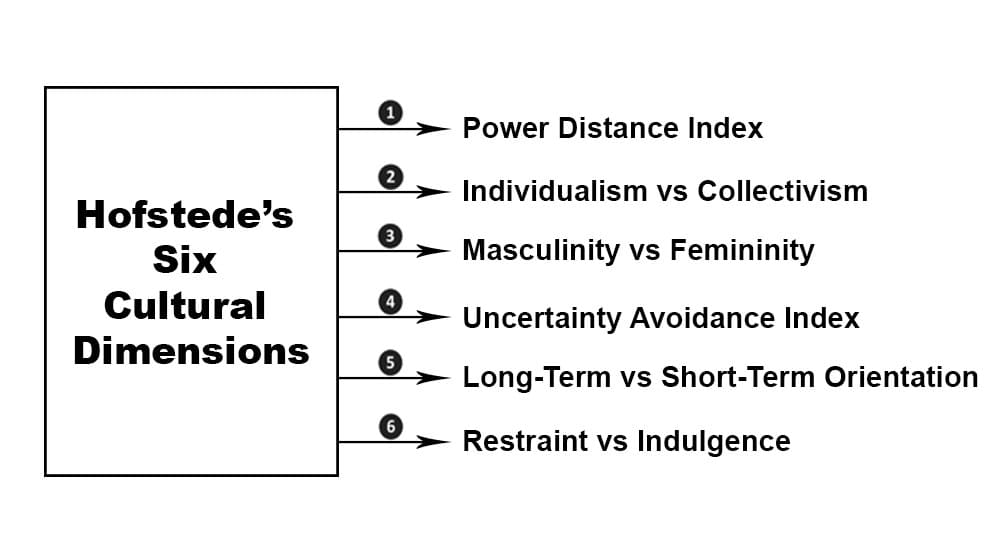Hofstede’s cultural dimensions theory helps address the behavior or interactions between cultures. It is incorrect to group an entire community or country into one group and expect the same behaviors from all individuals in the group.
This article discusses Hofstede’s cultural dimensions model and explains how it can help avoid stereotyping and wrong assumptions.
Geert Hofstede was a social scientist from the Netherlands and developed this framework in 1980 by analyzing more than 88,000 staff from 72 nations in IBM subsidiaries. He created this framework based on how beliefs and values contradict work objectives.
Hofstede’s Cultural Dimensions Theory delivers a framework that defines the effects of culture on its members’ values and how these values relate to behavior. Hofstede’s work is a significant resource in cross-cultural psychology, international management, and cross-cultural communication.
What is Hofstede’s Cultural Dimensions?
The business world is not restricted to geographical boundaries; it is interconnected and operates in a global environment. Employees in big organizations work with individuals from different countries with different cultural backgrounds.
Functioning in a multicultural environment is a reality, and it is vital to understand cultural differences to help solve problems arising from inter-cultural conflicts. It is a fact that most people are absorbed in their culture and cannot see its impact on others.
Cultural norms impact interpersonal relationships at work. The framework provided by this theory helps to find ways to do business across different cultures and assess their impact on a business.
Hofstede’s Cultural Dimensions Theory is used widely in several cross-cultural fields like cross-cultural communication, international management, and cross-cultural psychology.
Hofstede’s Six Dimensions of Culture

Hofstede’s six cultural dimensions are:
- Power Distance Index
- Individualism Versus Collectivism
- Masculinity Versus Femininity
- Uncertainty Avoidance Index
- Long-Term Versus Short-Term Orientation
- Restraint Versus Indulgence
#1. Power Distance Index (PDI)
Power Distance Index is the first dimension of Hofstede’s Cultural Dimension theory. It shows the inequality between individuals with power and without power. A lower index indicates that people question authority and attempt to distribute power.
In contrast, a higher index signifies that society has established a hierarchy, and people accept the unequal distribution of power and the status of a leader. The culture conforms to the power difference and inequality and respects authority and rank.
Important characteristics include:
- Complicated hierarchies
- Centralized organizations
- Large gaps in compensation
Low Power Distance Index shows that the power is spread and shared. According to this dimension, one should delegate and involve everyone in decision-making. This culture promotes a flat organizational structure, and the onus is on participative management and decentralized decision-making.
Important characteristics include:
- Flat organizations
- Distribution of power equally between supervisors and employees
#2. Individualism Versus Collectivism
Individualism Versus Collectivism is the second dimension of Hofstede’s Cultural Dimension theory. It examines how individuals are integrated into a specific community and made aware of dependence and obligation.
Individualistic societies have flexible ties and links to the individual’s relationship with the family. People don’t take responsibility for others’ actions and focus on individual achievement.
Collectivism relates to integrated relationships in a society that extends to families and groups. People are faithful to their group and take accountability for one another. They are committed to their group, supporting all its members’ best interests.
A high IDV (Individualism Versus Collectivism) score enables the accomplishments of an individual.
Important characteristics include:
- Respect for privacy
- The expectation of individual recognition and rewards
- Enjoying challenges
- Time, freedom, and privacy have high values
A low IDV score exhibits that hiding emotions can jeopardize harmony. It holds that wisdom is essential, and one should never deliver negative feedback or comments in public.
Important characteristics include:
- Maintaining group rapport and harmony is most important
- Focus is on acquiring and being skilled
#3. Masculinity Versus Femininity
Masculinity versus Femininity is the third dimension of Hofstede’s Cultural Dimension theory. It guides the role distribution between males and females in society.
Masculinity is an inclination for assertiveness, heroism, achievement, and material rewards in society. ; Femininity is an inclination for modesty, cooperation, and caring for the weaker individuals in the community.
Women play a subservient part in a feminine society and share caring views equally with men. In a masculine community, men are assertive and competitive while women are nurturing. Being strong is considered a good characteristic in this society. There is always a gap between male and female values.
A high MAS score implies that people are encouraged by specific targets, and there is a benchmark for differentiated gender roles.
Important characteristics include:
- The sensation of importance and pride
- Strong ego
- Accomplishment, success, and money are essential
A low MAS score implies that success is accomplished through cooperation and negotiation, and work-life balance is essential in organizational culture.
Important characteristics include:
- Responsibility for the quality of life
- Consensual relationships
#4. Uncertainty Avoidance Index
Uncertainty Avoidance Index is the fourth dimension of Hofstede’s Cultural Dimension theory. It guides how people cope with anxiety and often describes society’s tolerance for uncertainty or vagueness.
Societies with high UAI scores support rigid or stiff laws, guidelines, and behavior codes. The people are obvious about their expectations, goals, and defined parameters initially, and there is a low tolerance for risk-taking and uncertainty.
Important characteristics include:
- Societal traditions
- People are permitted to be expressive and can show emotions
- Society is structured, traditional, and rigid
Societies with low UAI scores display acceptance of various ideas and thoughts. The environment is free-flowing, and people are relaxed and open. Titles have no role, and individuals capable of dealing with tough situations are respected. Rules and regulations are stiff; there is a high tolerance for risk-taking, ambiguity, and uncertainty.
Important characteristics include:
- Minimal urgency
- Inclination towards open-ended learning
- Open to change
- More inclined towards decision-making
#5. Long-Term Versus Short-Term Orientation
Long-Term Versus Short-Term Orientation is the next dimension of Hofstede’s Cultural Dimension theory. It refers to the connection and relationship of the past with current and future challenges.
Societies with high long-term exposure indicate that loyalty is valued and traditions are kept and honored. It focuses on the future and implicates a delay in short-term success to accomplish long-term success. The focus is on long-term growth, endurance, and persistence.
Important characteristics include:
- Humbleness and modesty
- Focus on commitments and virtues
- Thrift is valued
Societies with short-term views tend to place the onus on truth and consistency. They emphasize providing short-term success and burdening the present instead of the future. The focus is on quick results.
Important characteristics include:
- Focus on rights and values
- Powerful beliefs
#6. Indulgence Versus Restraint
Indulgence Versus Restraint is the sixth dimension of Hofstede’s Cultural Dimension theory. It evaluates the tendency of society to accomplish its desires.
Countries with high IVR scores facilitate the free fulfillment of an individual’s emotions and drives. Society encourages dialogues and debates in meetings, prioritizes mentoring, coaching, and feedback, and emphasizes work-life balance.
Important characteristics include:
- Having fun
- Enjoying life
- An optimistic approach
- Freedom of speech
Countries that have a low IVR score put their onus on suppressing gratification. There are strict social norms and more regulation of people’s behavior and conduct. People are proficient and avoid jokes and fun activities in informal sessions.
Important characteristics include:
- Rigid and controlled behavior
- Pessimistic attitude
Strengths of Hofstede’s 6 Cultural Dimensions Model
- Hofstede’s Cultural Dimension model helps reflect on personal assumptions regarding norms.
- A non-profit organization can use this approach to review its anticipations or expectations, and behaviors. It will assist in refining and expanding fundraising practices.
- Multinational managers use Hofstede’s Cultural Dimension to increase employees’ motivation levels and minimize conflicts. It will improve the performance of a business organization.
Limitations of Hofstede’s 6 Dimensions Model
- One limitation lies in the original research methodology. The survey was limited to IBM’s employees and only included sales and marketing personnel. Hence, people believe that Hofstede’s Cultural Dimension model is based on inconclusive research.
- The world has seen many modifications in cultural and political movements. Technology has progressed, and this change has revolutionized people’s thinking and behavior patterns worldwide. The theory must be reviewed and updated according to current conditions.
Why is Hofstede’s Cultural Dimensions Model Important?
The theory is prevalent in many fields. It is a research paradigm.
- It is implemented in cross-cultural communication, cross-cultural psychology, and international management.
- It can provide an overall view and a rough understanding of different cultures.
- The six-dimension model is valuable for global marketing as it studies country-wide values and not just business values.
- Firms modify their services and products based on local preferences and customs.
Example of Hofstede’s Cultural Dimension
If an automaker wants to sell cars in a country with an uncertainty avoidance index, they should concentrate on safety.
Situational Theory
Let’s look at an example of situational theory in expatriate management. According to the theory, it is not viable to have a universal approach to all conditions for all expatriates. Organizations should consider every culture unique and develop strategies for integrating them all.
Expatriate managers for Tesco in China interacted freely with local employees to learn and understand the Chinese culture. Through interaction, they learn how to adapt to the similarities and differences between the United Kingdom and Chinese cultures.
Key Points of Hofstede’s Six Dimensions of Culture Across Countries
Cultural norms play a part in interpersonal relationships at work. When a specific culture takes society’s behavioral standards for granted, it is essential to think about the reactions, preferences, and feelings, provided that they don’t deviate too much from the society’s central tendencies.
However, things are suddenly different when an individual step into a foreign culture and doesn’t want to offend. Hofstede’s Cultural Dimensions can help organizations decide on their starting approach, decisions, and actions based on a general insight of how people in a particular society might think and react.
Using Hofstede’s model makes the unknown less intimidating, helps avoid mistakes, and provides a much-needed confidence boost when working in an unfamiliar country.
Conclusion
Hofstede’s Cultural Dimension helps organizations overcome the cultural and geographical differences that lead to ineffective communication between people from different countries and cultures. The theory is a means to understand discrepancies and create a harmonious environment without making a faux pas.
